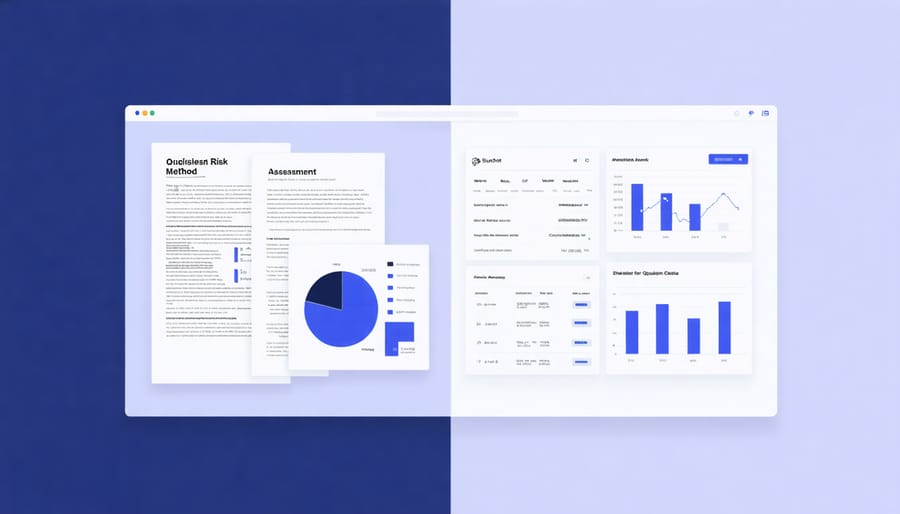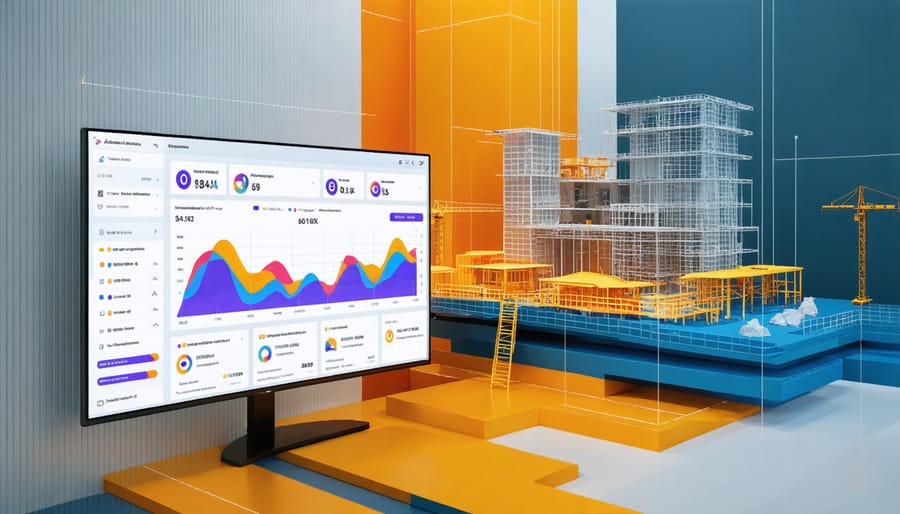In today’s high-stakes construction environment, quantitative risk management software transforms complex project uncertainties into measurable, manageable metrics. By leveraging advanced algorithms and real-time data analytics, these sophisticated platforms enable project managers to predict potential cost overruns, schedule delays, and safety incidents with unprecedented accuracy.
Modern QRM solutions integrate seamlessly with existing project management systems, providing decision-makers with data-driven insights that were previously impossible to obtain through traditional risk assessment methods. From Monte Carlo simulations to artificial intelligence-powered trend analysis, these tools empower construction professionals to make informed decisions backed by statistical confidence.
The construction industry’s rapid digital transformation has made quantitative risk management software not just a competitive advantage, but an essential component of successful project delivery. Leading firms now routinely achieve 15-20% reductions in risk-related costs while significantly improving project predictability and stakeholder confidence through systematic, software-driven risk analysis.
This comprehensive exploration examines how cutting-edge QRM platforms are revolutionizing construction risk management, offering practical insights for implementation and real-world examples of successful deployment across major infrastructure projects.
The Evolution of Construction Risk Management Software
Traditional vs. Quantitative Approaches
The evolution from traditional risk management methods to quantitative approaches represents a significant advancement in construction project management. While conventional methods relied heavily on subjective expert judgment and basic probability matrices, modern quantitative solutions leverage data analytics and advanced algorithms to deliver more precise risk assessments.
Traditional approaches often suffered from inconsistent evaluation criteria, limited historical data integration, and the inability to process multiple risk variables simultaneously. In contrast, quantitative risk management software employs sophisticated mathematical models, Monte Carlo simulations, and machine learning algorithms to analyze thousands of potential scenarios in minutes.
The advantages of quantitative analysis are compelling: more accurate risk probability calculations, better cost estimation, improved schedule forecasting, and data-driven decision-making capabilities. These tools can process vast amounts of historical project data, current market conditions, and real-time site information to generate actionable insights. This systematic approach not only reduces human bias but also enables construction teams to identify and mitigate risks before they impact project outcomes, leading to more reliable risk management strategies and improved project success rates.

Key Features of Modern Risk Management Platforms
Modern risk management platforms integrate several crucial capabilities essential for effective project risk assessment and mitigation. Real-time data analytics enables continuous monitoring of project variables, allowing teams to identify potential risks before they escalate into serious issues. These platforms typically feature advanced Monte Carlo simulation capabilities, providing accurate probability distributions for various risk scenarios and their potential impacts on project timelines and budgets.
Multi-dimensional risk modeling allows professionals to analyze interconnected risk factors simultaneously, offering a more comprehensive view of project vulnerabilities. Automated reporting and dashboard functionality present complex risk data in easily digestible formats, facilitating informed decision-making at all organizational levels.
Cloud-based collaboration tools ensure that risk information is accessible to all stakeholders, promoting transparent communication and coordinated response strategies. Integration capabilities with existing project management software, BIM systems, and financial tools create a seamless workflow for risk assessment and mitigation planning.
Advanced platforms also incorporate machine learning algorithms that analyze historical project data to improve risk prediction accuracy and suggest proven mitigation strategies based on past successes.
Real-Time Risk Assessment and Monitoring

Data Integration and Analytics
Modern quantitative risk management software excels in its ability to consolidate and analyze data from multiple sources, creating a comprehensive risk assessment framework for construction projects. These platforms integrate information from project schedules, cost estimates, weather data, historical performance metrics, and real-time site conditions to provide actionable insights.
The software typically employs advanced APIs and data connectors to seamlessly import information from various project management tools, financial systems, and IoT devices. This integration capability ensures that risk assessments are based on current, accurate data while maintaining proper data security considerations throughout the process.
Machine learning algorithms analyze these diverse data streams to identify patterns, correlations, and potential risk factors that might not be apparent through traditional analysis methods. For instance, the software can correlate historical weather patterns with project delays, material cost fluctuations with supplier performance, and workforce availability with project timelines.
Real-time analytics dashboards present this information through intuitive visualizations, enabling project managers to make informed decisions quickly. The software’s predictive capabilities can forecast potential risks by analyzing trends and historical data, while Monte Carlo simulations provide probability distributions for various project outcomes.
These integrated analytics capabilities transform raw data into strategic insights, allowing construction professionals to proactively address risks before they impact project success.
Predictive Risk Modeling
Modern quantitative risk management software leverages artificial intelligence and machine learning algorithms to revolutionize how construction projects predict and mitigate potential risks. These advanced systems analyze vast datasets from historical project information, current market conditions, and real-time project metrics to identify patterns and potential risk factors that might escape human observation.
The predictive modeling capabilities enable project managers to simulate various scenarios and their potential impacts on project timelines, costs, and resources. By processing multiple variables simultaneously, these systems can generate risk probability distributions and impact assessments with unprecedented accuracy. For example, the software can predict weather-related delays by analyzing historical weather patterns, seasonal construction data, and project scheduling information.
Machine learning algorithms continuously improve their predictive accuracy by learning from new data inputs and actual project outcomes. This adaptive capability allows the software to refine its risk assessments based on region-specific factors, contractor performance history, and supply chain dynamics. The system can also identify early warning indicators for potential issues, enabling proactive risk management rather than reactive problem-solving.
Advanced visualization tools within these systems present complex risk data in intuitive formats, helping stakeholders make informed decisions quickly. Real-time dashboards display risk metrics, probability curves, and trend analyses, while automated alerts notify team members when risk thresholds are approached or exceeded. This combination of predictive power and user-friendly presentation transforms raw data into actionable intelligence for effective risk management.
Case Study: Quantitative Risk Management in Action
The Metropolitan Transit Authority’s (MTA) expansion of the Grand Central Terminal in New York serves as a compelling example of successful quantitative risk management software implementation. This $11.2 billion project, completed in 2023, faced numerous challenges including complex underground construction, coordination of multiple contractors, and strict regulatory requirements.
The project team implemented advanced risk management software from the planning phase, utilizing Monte Carlo simulation and probabilistic cost analysis to evaluate over 2,000 potential risk factors. The software’s machine learning capabilities analyzed historical data from similar projects, helping identify patterns and potential issues before they materialized.
Key risk factors monitored included geological conditions, equipment failure probabilities, labor availability, and supply chain disruptions. The software’s real-time dashboard enabled project managers to track risk metrics continuously and adjust strategies accordingly. When unexpected ground conditions were encountered during tunneling, the system immediately calculated the impact on project timeline and costs, allowing for swift mitigation measures.
The software’s predictive analytics highlighted a potential delay in specialized equipment delivery six months before it became critical. This early warning enabled the procurement team to secure alternative suppliers, preventing what could have been a three-month delay and saving approximately $4.2 million in potential cost overruns.
Throughout the project, the risk management platform maintained a database of risk responses and their effectiveness, creating a valuable knowledge base for future reference. The system’s automated reporting features kept stakeholders informed through customized risk assessment reports, facilitating transparent communication and timely decision-making.
The implementation resulted in:
– 15% reduction in overall project risk exposure
– $23 million in cost savings through early risk identification
– 30% improvement in risk response time
– 95% accuracy in risk impact predictions
This case demonstrates how quantitative risk management software can transform complex construction projects from reactive to proactive risk management, delivering tangible benefits in cost control, schedule adherence, and stakeholder satisfaction.
Implementation Strategies and Best Practices
Integration with Existing Systems
Successful integration of quantitative risk management software with existing project management systems requires a systematic approach and careful planning. Begin by conducting a thorough assessment of your current technology infrastructure, including project management platforms, document control systems, and scheduling tools. This evaluation will help identify potential integration points and technical requirements.
Create a detailed integration roadmap that outlines the necessary API connections, data mapping requirements, and security protocols. Most modern risk management solutions offer pre-built connectors for popular construction management platforms like Procore, Primavera P6, and Microsoft Project. These connectors facilitate automated data synchronization and real-time risk updates across systems.
Establish a phased implementation schedule to minimize disruption to ongoing projects. Start with a pilot program involving a single project or department to test the integration and identify any potential issues. During this phase, focus on data validation and user acceptance testing to ensure accuracy and reliability.
Configure custom workflows that align with your organization’s existing processes. This includes setting up automated alerts, approval chains, and reporting mechanisms that complement your current project controls. Provide comprehensive training to team members, emphasizing the integrated features and new capabilities available through the connected systems.
Regular system audits and performance monitoring will help maintain optimal functionality and ensure continued alignment with project objectives.

Team Training and Adoption
Successful implementation of quantitative risk management software requires a well-structured training and adoption strategy across all organizational levels. Begin by identifying key stakeholders and establishing a core team of power users who will champion the software’s adoption. These champions should receive comprehensive training and serve as internal resources for their colleagues.
Develop a phased training approach, starting with basic functionality and gradually introducing advanced features. This prevents overwhelming users and allows for better retention of knowledge. Create role-specific training modules that focus on relevant features for different team members, from project managers to field supervisors.
Regular workshops and hands-on sessions help reinforce learning and address specific challenges users encounter. Supplement these with easily accessible documentation, video tutorials, and quick reference guides. Consider implementing a mentorship program where experienced users can guide newcomers.
Track adoption metrics and gather feedback to identify areas requiring additional support. Common resistance points often include data entry complexity and report generation. Address these through targeted training sessions and workflow optimization. Maintain open communication channels with the software vendor’s support team to leverage their expertise and resources.
Celebrate early wins and share success stories to maintain momentum and demonstrate the software’s value to the organization. Regular refresher courses ensure sustained proficiency as the software evolves with updates and new features.
Future Trends and Developments
The landscape of quantitative risk management software is rapidly evolving, driven by technological advancements and changing industry needs. Machine learning and artificial intelligence are becoming increasingly integral, enabling more accurate risk prediction models and automated pattern recognition in project data. These systems are expected to develop more sophisticated capabilities in identifying potential risks before they materialize, offering unprecedented predictive power.
Cloud-based solutions are gaining prominence, facilitating real-time collaboration and data sharing across project teams. This trend is likely to accelerate, with software platforms offering enhanced mobile accessibility and integration with IoT devices for live project monitoring and risk assessment.
Digital twin technology is emerging as a game-changer, allowing construction professionals to create virtual replicas of projects for comprehensive risk simulation. This technology enables teams to test various scenarios and their potential impacts before implementation, significantly improving risk mitigation strategies.
Blockchain integration is another promising development, offering improved transparency and security in risk-related data management. This technology could revolutionize how project stakeholders share and verify risk-related information, ensuring data integrity and creating immutable audit trails.
The future also points toward increased customization capabilities, with software becoming more adaptable to specific project types and organizational needs. We’re likely to see the emergence of modular systems that allow companies to select and combine risk management features based on their unique requirements.
Experts anticipate greater integration with Building Information Modeling (BIM) systems, creating a more holistic approach to risk management throughout the project lifecycle. This integration will enable better visualization of risks within the context of the actual project model, enhancing decision-making capabilities.
Quantitative risk management software has revolutionized how construction professionals approach project planning and execution. By providing data-driven insights and sophisticated analytical capabilities, these tools have become indispensable for modern construction management. The ability to identify, quantify, and mitigate risks with greater precision has led to significant improvements in project outcomes, cost control, and schedule adherence.
For construction professionals looking to enhance their risk management practices, the adoption of these software solutions represents a critical step toward more informed decision-making. The integration of historical data, real-time monitoring, and predictive analytics enables teams to respond proactively to potential challenges rather than reactively to problems as they arise.
Key takeaways include the importance of selecting software that aligns with specific project needs, ensuring proper team training and implementation, and maintaining consistent data input practices. The return on investment becomes evident through reduced insurance costs, fewer project delays, and more accurate budget forecasting. As the construction industry continues to evolve, quantitative risk management software will remain essential for maintaining competitiveness and delivering successful projects in an increasingly complex business environment.

